Imagine that you talk to one of your clients from the USA and instead of a brief small talk, you go straight to the point of your meeting. Or you disagree with the Japanese stakeholder in a straightforward manner. The best case scenario, the client finds you weird. The worst–they will think you’re not familiar with their culture at all and therefore it might become a trouble on much more serious levels than just casual conversation. Cultural differences can sometimes make it or break it.
Meeting people from various countries and cultural backgrounds is common for project managers in a software development company like HuviTek. As we work with clients from all over the world, I find it crucial to know HOW to work with them so that the client is happy and cooperation goes smoothly.
So, how to deal with it? The key is to identify the differences, understand how they can influence areas of daily business cooperation and then learn how to act in certain situations.
In this article I’m going to talk more about four areas: communication, trust, feedback and persuasion which I find especially important for the project success. I’ll also share with you the tips I learned during my PM’s journey and show you that it’s not so difficult after all. Let’s embrace the culture.
The Importance of Culture Awareness
The influence of cultural differences on main areas of conducting business is extensive. It impacts everything from how people convey messages, how negotiations are handled and trust is built. Knowing these things and how they vary across cultures gives you a huge advantage as a Project Manager.
The first thing that I would call the benefit of being aware of cultural differences is basically better cooperation with other people. Fewer misunderstandings, more clarity. Besides that, culture awareness helped me:
- Understand how the cultural framework I work with is different from the one I grew up in.
- Realize how biased I was thinking that patterns I followed in my daily business interactions are dominant and generally binding.
- Solve problems quicker and easier.
- Take certain project situations less personally.
- Reduce stress.
What’s more, learning about cultural differences is taking care of diversity in the workplace. Developing your cultural awareness lets you have more meaningful interactions with those around and brings people together.
Business Areas Influenced by Culture
How to squeeze something rather intangible as culture? In my opinion one of the best and most comprehensive ways is using scales compiled by Erin Meyer in her bestselling book “The Culture Map” (highly recommended!). She’s the professor at INSEAD, one of the leading international business schools who taught thousands of executives how to work more effectively across cultural differences. Meyer mapped on a scale eight factors that are related to business interactions and can be seen very differently across the globe.
- Communication: the way we create messages (low-context vs. high-context)
- Evaluating: the way we provide feedback and share criticism (direct negative feedback vs. indirect negative feedback)
- Persuading: the way we negotiate (principle-first vs. application-first)
- Leading: how we see the strong leadership (egalitarian vs. hierarchical)
- Deciding: how the process of making decision looks (consensual vs. top-down)
- Trusting: how we build mutual trust (task-based vs. relationship-based)
- Disagreeing: our ability to disagree openly (confrontational vs. avoids confrontation)
- Scheduling: what is our approach to time and planning (linear vs. flexible)
Communication – Low vs. High Context
Analyzing communication from a cultural perspective lets us understand how various cultures build and convey message so in general how people from different cultures see what it means to be a good speaker. What are the two angles of the scale?
Low context:
In low-context culture people may perceive high-context communicators as secretive, lacking transparency or unable to communicate effectively.
- In the US and other Anglo-Saxon cultures: people are trained to communicate as literally and explicitly as possible – good communication is all about clarity.
- If the message isn’t understood, the fault is held by the sender.
- Repetition is appreciated if it helps clarify the communication.
High context:
In high-context culture people may perceive low-context communicators as inappropriately stating the obvious (“You talk to us like we are children”.)
- Messages are often conveyed implicitly, requiring the listener to read between lines.
- Good communication is subtle, layered.
- The responsibility for understanding the message is shared between the one who sent it and the one receiving it
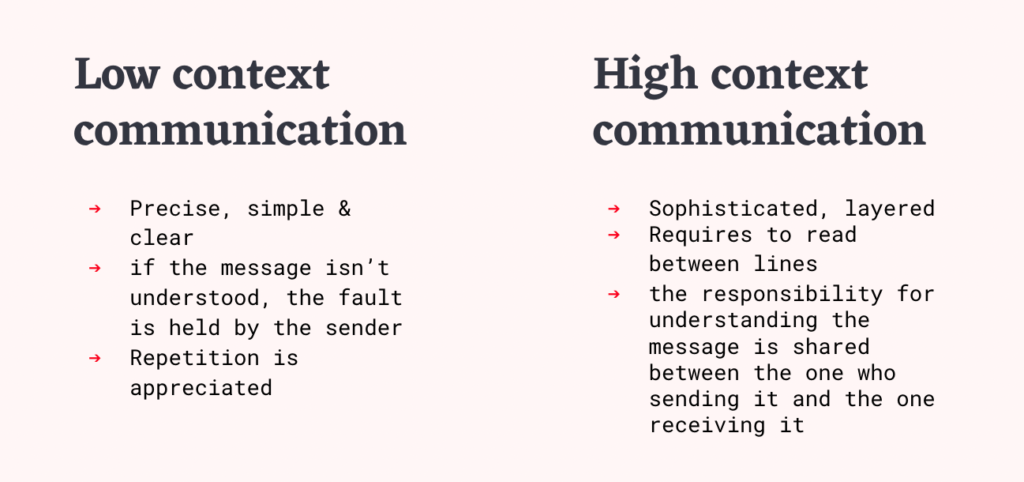
Tips
- Low-context culture: start your conversation by stating the main idea, make your points clearly, at the end summarize what has been decided and what will happen next, ask if your message was clear enough, then follow up with an email.
- High-context culture: learn to listen what a message meant instead of what has been said.
- Look for “no” between the lines (even if the first sentence starts with a “yes”).
No matter the culture, I recommend these universal communication practices that we use to keep our clients happy and in the loop.
How are cultures placed on the communication scale?
- Japan is seen as the highest-context culture in the world.
- US is seen as the lowest context culture in the world followed by Canada, Australia, the Netherlands, Germany and the UK as the highest-context culture from the Anglo-Saxon cluster
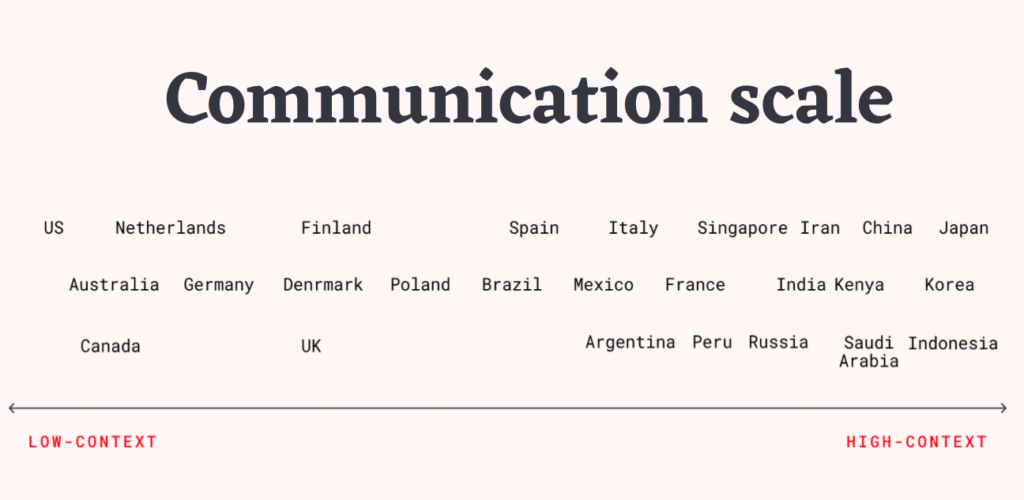
Written communication
When talking face-to-face, it’s generally easier to understand a speaker’s intent and even adjust to their communication style. But the written word is less forgiving. Messages could be misunderstood because of little things such as a greeting or lack of it, response time or explicitness.
Low-context culture:
Etiquette says that even if you have nothing to say, it would be nice as a receiver to inform the other side when you will have. Silence means something negative, potential problems.
Low-context cultures favor communicating with the use of organizational charts (showing who works for whom), titles (describing who is on what level), written objectives (explaining who is responsible for accomplishing what).
High-context culture:
It’s pretty common to receive a reply after 4 days saying “Sure, we did it” so don’t take the waiting time personally. Written documentation is less necessary as it may be treated as lack of trust instead of professionalism.
Evaluating – Direct vs. Indirect feedback
This one is tough. I would say giving (and receiving) negative feedback is generally not the easiest thing in the world and when you add a different culture-based approach to the table, it can get tricky.
Generally we divide feedbacking process into direct or indirect. The first one is characterized by honesty where negative messages are straightforward and not softened by some positive aspects. More indirect cultures on the other hand, apply tons of diplomacy into that and appreciate being rather delicate, criticizing only in private and wrapping the “bad news” around some positive messages.
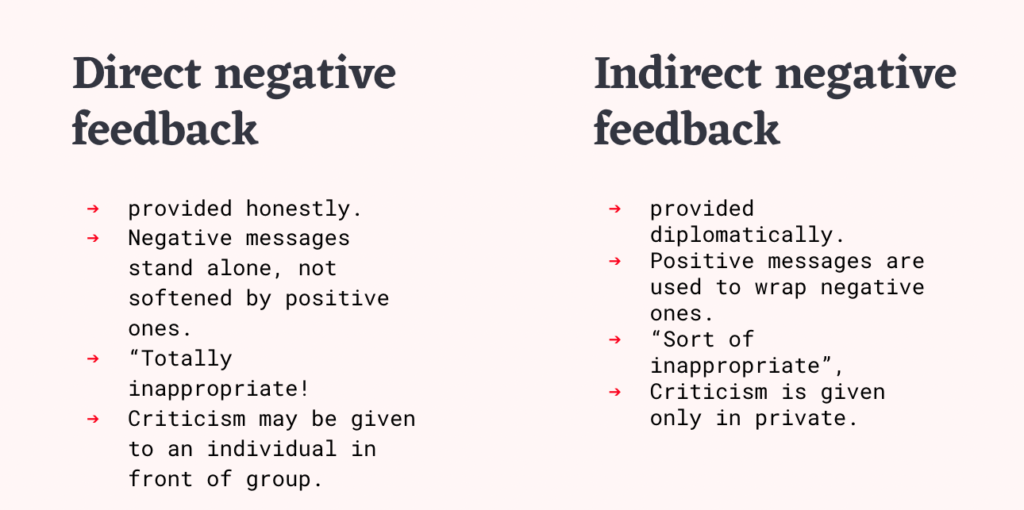
“Evaluating” factor lets us understand that managers in different parts of the world are conditioned to give feedback in a drastically different way.
Examples:
Chinese managers never criticize a colleague openly, in front of others.
Russian managers learn to be honest and gives the message straight
American managers are trained to wrap positive messages around negative ones.
French managers are trained to criticize passionately.
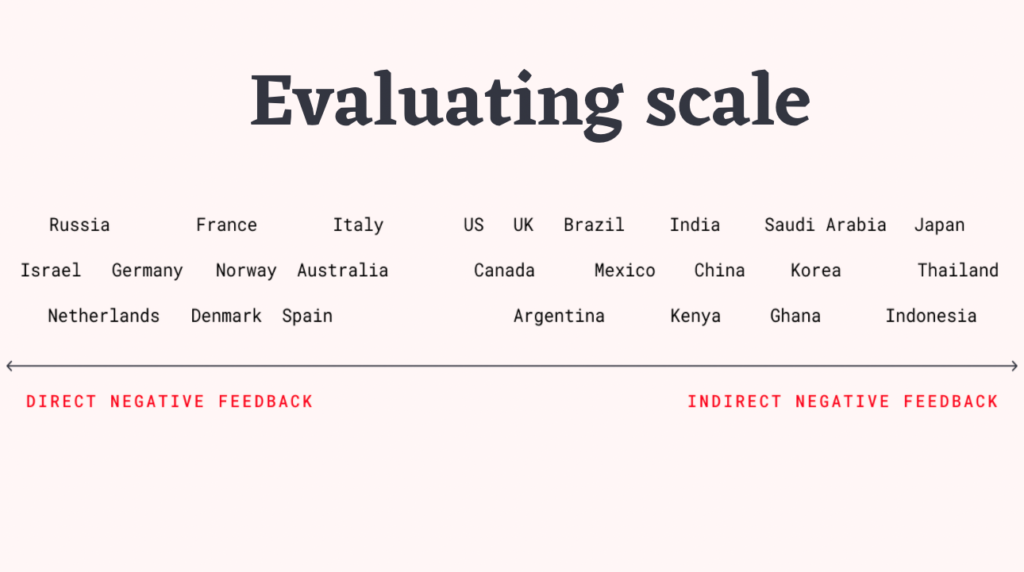
Some countries are differently located on the communication map than on the evaluating scale. For example, Americans are low-context but indirect negative feedback culture, French are high-context, but pass negative feedback directly.
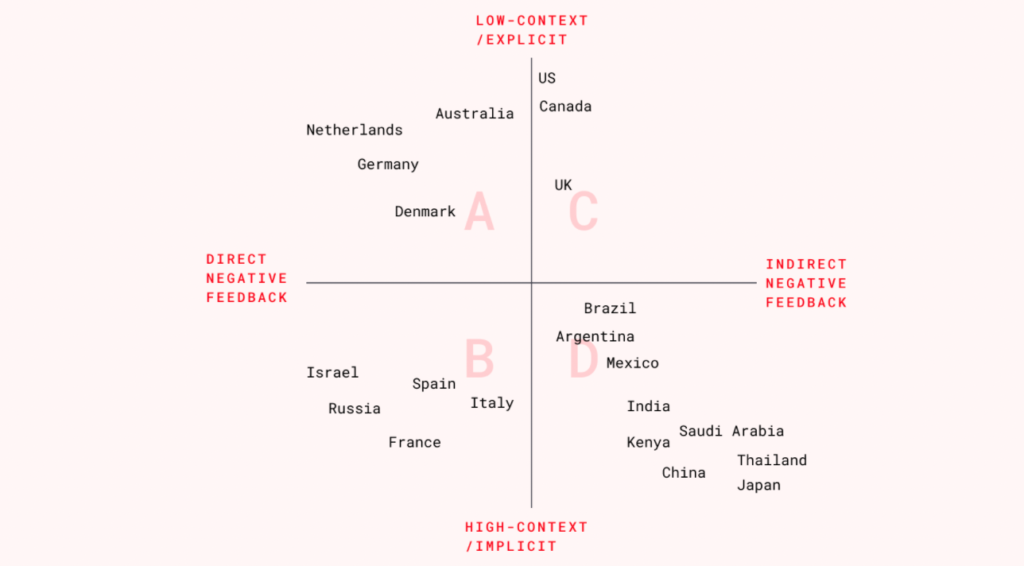
High context and direct feedback:
- Russia: between the line communication style but direct negative feedbacking very sharp
Low-context and indirect negative feedback
- USA: giving 3 positives for every negative
- For most direct negative feedbackers US feedbacking is confusing and false
Tips
So, how to get around these rules and not get crazy?
Approaching indirect feedback culture:
- Don’t give negative feedback to an individual in front of others – people may feel offended, EVEN if you do it politely.
- This also concerns positive feedback – people can feel uncomfortable when you point them out publicly.
- The technique of blurring the message: give feedback slowly, wait until it sinks in.
- Use food and drink to blur an unpleasant message – once people are relaxed it’s easier to give and take feedback, even the negative one.
Approaching direct feedback culture:
- Don’t follow the crowd, you can go too far and get it wrong – we often don’t have the full knowledge of what is appropriate and what is not.
- Accept direct criticism in a positive manner.
- Try to explain how it works in your culture.
Persuading: Principle-first vs. Application-first
Persuading may be also seen differently across the globe. It shows how different cultures build arguments to persuade successfully. It’s a very useful skill for project managers when we need to convince clients or the team to follow certain approaches during development. Persuading depends on two styles of reasoning: principle first and application first.
Principle-first: based on deductive reasoning, derives conclusions or facts from general principles or concepts.
Example: All technologies get old. > Node.js is a technology > Node.js will eventually die out.
- You start from a general principle and move from it to a practical conclusion.
- It is based on the educational system where 80% is dedicated to concepts and theories; 20% to applying those principles to concrete problems.
- In the business world of principle-first culture it’s important to explain the reason for doing something first instead of going straight to the point of how to achieve a certain result.
Application-first: based on inductive reasoning; general conclusions are reached based on a pattern of factual observations from the real world.
Example: “We’ve always used Jira for keeping track of the project’s progress and it’s worked well. So I think that Jira is necessary for our next project, too.”
- It’s related to Anglo-Saxon educational system where 80% time is spent on the concrete tool and how to apply it and 20% on considering its conceptual or theoretical explanations.
- In the business world of application-first culture focus on how to do something rather than why in the first place.
USA: Get straight to the point!
Germany: They are intelligent people. Why would they swallow my argument if I haven’t built it carefully for them from the ground up?
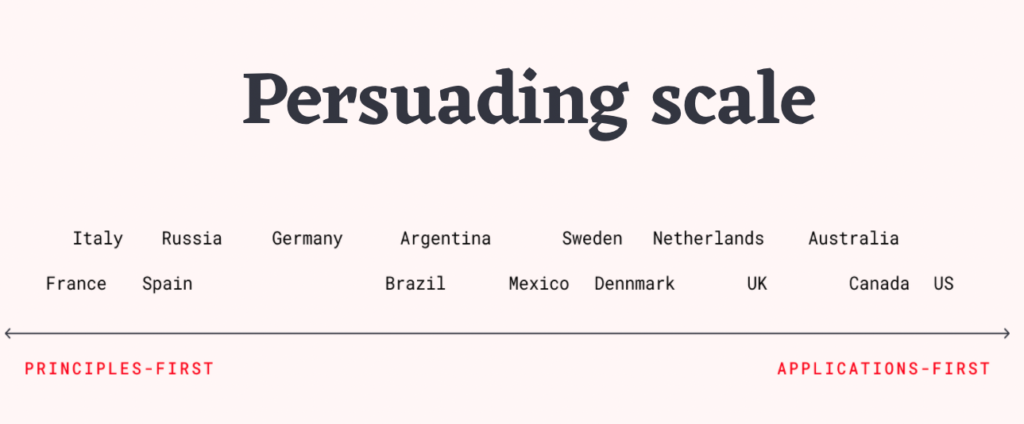
Most people are capable of practicing both BUT:
- Application-first thinkers like to receive practical examples up front – they will extract learning from these examples, they like case studies
- Principle-first people also like practical examples BUT they need to understand the basis of the framework before they move to the application.
It’s extremely useful when we try to explain and negotiate different approaches in software development. What if you talk to a mixed group of people? As both groups know how to combine both, try to go back and forth between theoretical principles and practical examples. Remember to keep the balance and things should work out eventually.
Trusting – Task-based vs. Relationship-based
You can have perfect communication skills and understand the other person’s feedbacking culture but when there’s no mutual trust, the relationship is on the line. Trust is key to any project success. So let’s see how trust-building looks across cultures.
The trust between people from different cultures is built based on two types of trust: affective trust and cognitive trust.
- Affective trust: arises from feelings of emotional closeness, empathy and friendship. This type of trust comes from the heart. We laugh together, relax together, and see each other on personal leave, so that we feel affection or empathy for you and sense that you feel the same for me. Result: we trust you.
- Cognitive trust is based on the confidence you feel in another person’s accomplishments, skills and reliability. Often built through business actions: we work together, you do your work well, and you demonstrate through the work that you are reliable, pleasant, consistent, intelligent and transparent. Result: we trust you.
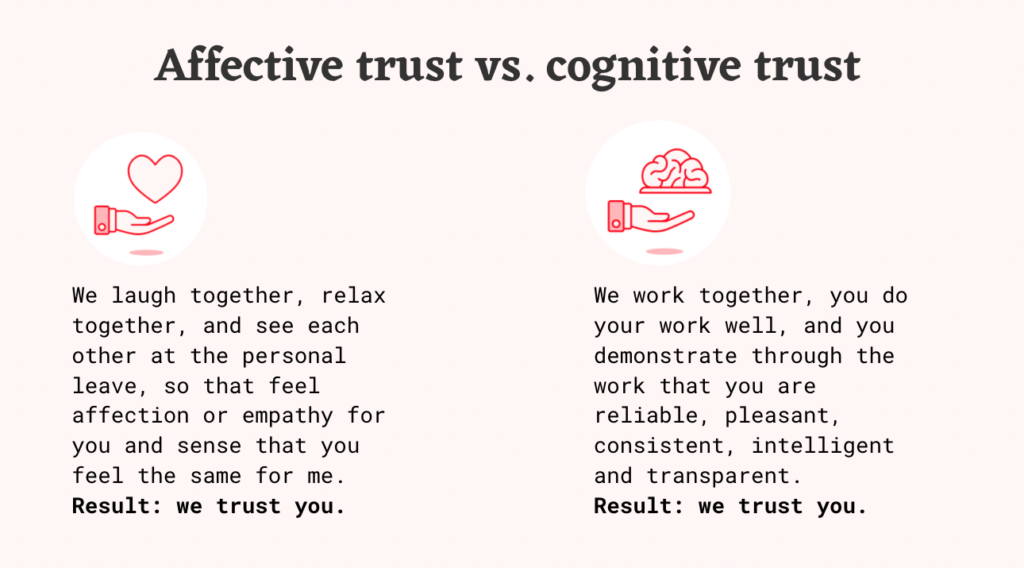
Business is business. Americans are representing task-based trust. A clear line between cognitive and affective trust. They think mixing in business is unprofessional.
Business is personal. Chinese are representing relationship-based trust. They mix both approaches.
In US and Switzerland: business is business, in countries like Brazil or China: business is personal.
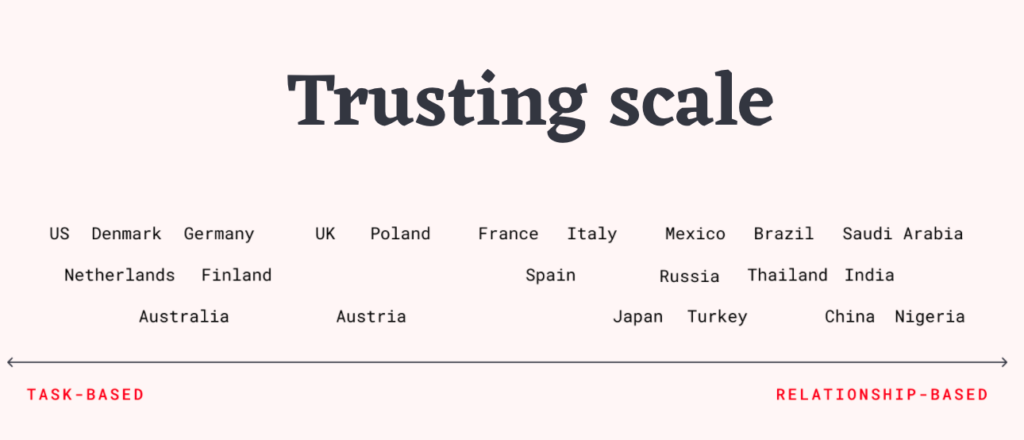
Tips
How to approach different cultures of trust? First, choose your communication medium.
- Choose meetings in relationship-based trust cultures to build a strong relationship. For tasked-based trust cultures, emails are fine on every stage of the relationship.
- To approach relationship-based trust cultures, look for the things in common on which you can build a relationship, take into consideration different ways of spending time, interests, food preferences.
Let’s Embrace Culture!
Although cultural differences might be troublesome in project management, we might look at them as enrichment of our daily work and personal growth opportunity.
My last advice for moving smoothly in different cultural frameworks would be – when interacting with someone from another culture, try to watch more, listen more, and speak less.
“You have two eyes, two ears and one mouth. Use them accordingly.” – Erin Meyer



